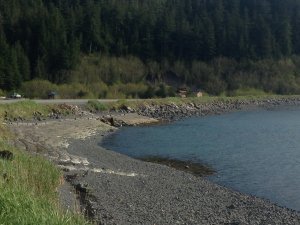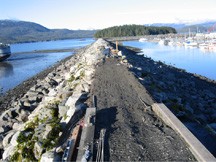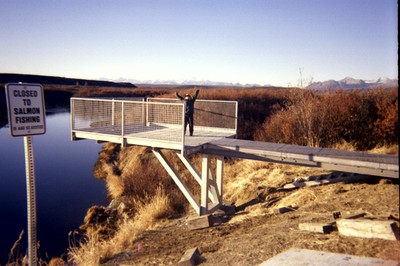Getting out and seeing the watershed first hand is the best way to get to know this place. CRWP works with partners to provide accessible, enjoyable trails and recreation opportunities that allow users to enjoy this amazing place while reducing their impact on the natural ecosystem.
Shelter Cove Recreational Access
 CRWP has teamed up with the City of Cordova to improve recreational access at Shelter Cove for sport fishermen, kayakers, intertidal explorers and others. Since 1990, Prince William Sound Aquaculture Corporation and later Alaska Department of Fish & Game (1999), have been releasing coho and Chinook salmon smolt at this site in order to enhance sport fishing opportunities in an accessible location in Cordova. With funding from the U.S.D.A. Secure Rural Schools Title II program, we aim to develop infrastructure that provides safe, ADA compliant access for anglers, a public point of access to Prince William Sound for kayakers, and access for educational programs exploring the intertidal and near-shore environments at Fleming Spit. Installation of the new infrastructure is scheduled for spring 2019, after Alaska Department of Transportation & Public Facilities replaces the culverts and removes the aging cement ramp and pillows in 2018. Contact CRWP for more information on planning workshops or to share your ideas or download the project flyer here.
CRWP has teamed up with the City of Cordova to improve recreational access at Shelter Cove for sport fishermen, kayakers, intertidal explorers and others. Since 1990, Prince William Sound Aquaculture Corporation and later Alaska Department of Fish & Game (1999), have been releasing coho and Chinook salmon smolt at this site in order to enhance sport fishing opportunities in an accessible location in Cordova. With funding from the U.S.D.A. Secure Rural Schools Title II program, we aim to develop infrastructure that provides safe, ADA compliant access for anglers, a public point of access to Prince William Sound for kayakers, and access for educational programs exploring the intertidal and near-shore environments at Fleming Spit. Installation of the new infrastructure is scheduled for spring 2019, after Alaska Department of Transportation & Public Facilities replaces the culverts and removes the aging cement ramp and pillows in 2018. Contact CRWP for more information on planning workshops or to share your ideas or download the project flyer here.
Cordova Breakwater Trail
 With funding from the Alaska Recreational Trail Grants program, the City of Cordova, and time donated from many volunteers, CRWP constructed a walking trail on top of the Cordova Harbor Breakwater. Now visitors and residents have a level walking surface to visit one of the Cordova waterfront’s most scenic vistas.
With funding from the Alaska Recreational Trail Grants program, the City of Cordova, and time donated from many volunteers, CRWP constructed a walking trail on top of the Cordova Harbor Breakwater. Now visitors and residents have a level walking surface to visit one of the Cordova waterfront’s most scenic vistas.
Gulkana River Salmon Viewing Platform
 When CRWP worked on creating a new trail to Fish Creek at mile 190 on the Richardson Highway in 2001, our crew leader noticed how many people walked down the bank to look at salmon in the Gulkana River at the motorists’ pull-out. In 2002, we applied for and were awarded funding to construct this salmon viewing platform, and the State Parks & Recreation Division created two interpretive signs that are installed on the platform. The platform protects bank vegetation from foot traffic, and provides a safe viewing opportunity for visitors.
When CRWP worked on creating a new trail to Fish Creek at mile 190 on the Richardson Highway in 2001, our crew leader noticed how many people walked down the bank to look at salmon in the Gulkana River at the motorists’ pull-out. In 2002, we applied for and were awarded funding to construct this salmon viewing platform, and the State Parks & Recreation Division created two interpretive signs that are installed on the platform. The platform protects bank vegetation from foot traffic, and provides a safe viewing opportunity for visitors.



